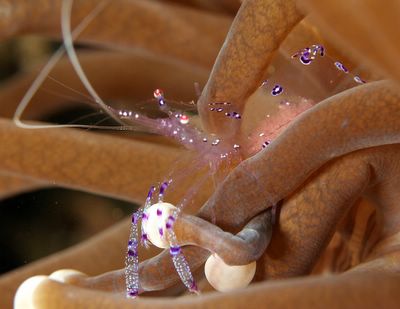 Could this be a Spanish Dancer?March 3, 2006 From: Brian Francisco
Could this be a Spanish Dancer?March 3, 2006 From: Brian FranciscoHi Bill:
Is it possible that these photos are of a juvenille Spanish Dancer
Hexabranchus sanguineus. This individual was quite small, about 12 mm, and I'm not sure I can count 6 gills.

Locality: Beach, 7 meters, East Timor, Banda Sea, 26 February 2006, Sandy Bottom. Length: 12mm. Photographer: Brian Francisco.
Thanks very much
Brian Francisco
Francisco, B., 2006 (Mar 3) Could this be a Spanish Dancer?. [Message in] Sea Slug Forum. Australian Museum, Sydney. Available from http://www.seaslugforum.net/find.cfm?id=16000Dear Brian,
Yes this is indeed a juvenile
Hexabranchus. Good call! The gills in juveniles are quite interesting. The dorid nudibranchs are divided into two large groups depending on whether their gills can retract into a protective pocket
Cryptobranchia or
Eudoridoidea or do not have such a pocket
Phanerobranchia or
Anadoridoidea. Obviously in adults,
Hexabranchus has no sign of a gill pocket and each gill is separately inserted into the skin. It would seem to be clearly a phanerobranch. However phanerobranchs are usually the elongate forms, such as the nembrothids, while the large flat dorids with wide mantle skirts are usually cryptobranchs, with a gill pocket. Cryptobranchs are also sponge feeders, like
Hexabranchus, while the phanerobranchs are all specialised feeders on a wide variety of invertebrates. There are of course other anatomical differences.

However if you look at juvenile
Hexabranchus, you can see there seems to be a ridge around the gills and the tissue inside that is translucent, without the colour pattern of the rest of the mantle. I wouldn't be surprised if that is all that is left of a gill pocket, which has been lost in the evolution of this species, but is still indicated in juveniles. Does that make
Hexabranchus a very special cryptobranch, or does it suggests that it is a link between the two groups, indicating that the phanerobranchs evolved from the cryptobranchs? I wouldn't like to say.at this stage, but it is certainly something that students of phylogeny should consider. I'm glad you picture shows it so clearly. In living animals they gills can almost completely disappear.
Best wishes, Bill Rudman
Rudman, W.B., 2006 (Mar 3). Comment on Could this be a Spanish Dancer? by Brian Francisco. [Message in] Sea Slug Forum. Australian Museum, Sydney. Available from http://www.seaslugforum.net/find.cfm?id=16000




 However if you look at juvenile Hexabranchus, you can see there seems to be a ridge around the gills and the tissue inside that is translucent, without the colour pattern of the rest of the mantle. I wouldn't be surprised if that is all that is left of a gill pocket, which has been lost in the evolution of this species, but is still indicated in juveniles. Does that make Hexabranchus a very special cryptobranch, or does it suggests that it is a link between the two groups, indicating that the phanerobranchs evolved from the cryptobranchs? I wouldn't like to say.at this stage, but it is certainly something that students of phylogeny should consider. I'm glad you picture shows it so clearly. In living animals they gills can almost completely disappear.
However if you look at juvenile Hexabranchus, you can see there seems to be a ridge around the gills and the tissue inside that is translucent, without the colour pattern of the rest of the mantle. I wouldn't be surprised if that is all that is left of a gill pocket, which has been lost in the evolution of this species, but is still indicated in juveniles. Does that make Hexabranchus a very special cryptobranch, or does it suggests that it is a link between the two groups, indicating that the phanerobranchs evolved from the cryptobranchs? I wouldn't like to say.at this stage, but it is certainly something that students of phylogeny should consider. I'm glad you picture shows it so clearly. In living animals they gills can almost completely disappear.